Uncategorized
Trump slams Democrats for ‘rage-fueled resistance’

ROCHESTER, Minn. — Seeking to boost Republican turnout in key Minnesota battlegrounds, President Donald Trump attacked Democrats Thursday night, arguing that their “rage-fueled resistance” to his Supreme Court nominee will motivate GOP voters this fall.
Speaking before a cheering crowd at a rally in Rochester, Trump praised Judge Brett Kavanaugh, whose nomination has faltered amid accusations of sexual misconduct. Of Democrats, he said, “Their rage-fueled resistance is starting to backfire at a level nobody has ever seen before.”
Added Trump: “Do we love it? We love it. Because people see what’s happening and they don’t like it.”
As Republicans face a tough midterm election cycle, Trump is trying to boost turnout. The GOP is hoping to fend off a Democratic effort to recapture the House of Representatives.
Trump landed in Minneapolis in the afternoon and headed to a fundraiser before
Stressing the stakes, Trump said, “On Nov 6, I need your vote, I need your support to stop radical Democrats and elect proud Minnesota Republicans.”
In a sustained attack on Democrats, Trump said they would raise taxes, increase regulations and stall economic gains. He slammed party leaders, including House Minority Leader Nancy Pelosi. And he accused the Democrats of desperately grabbing at power, saying, “They want to resist, they want to obstruct, they want to delay, demolish, they want to destroy.”
Outside Washington, the focus still remained on the dramatic confirmation process for Trump’s Supreme Court nominee. Trump told reporters he thinks Kavanaugh is “doing very well” as senators weigh a new FBI background report prompted by allegations of sexual misconduct. At the rally, he did not repeat his mockery of Kavanaugh’s accuser Christine Blasey Ford from earlier in the week.
Trump earlier tweeted his support for Kavanaugh, who is accused of a sexual assault at a high school party, saying, “Due Process, Fairness and Common Sense are now on trial!” Trump has sought to use the Kavanaugh confirmation conflict to appeal to white men, arguing that the accusations are proof that innocent men could be unfairly targeted.
As Kavanaugh aggressively pushes back against allegations of misconduct, Trump mocked former Sen. Al Franken, a Minnesota Democrat, for quickly resigning over allegations of improper
“Boy did he fold up like a wet rag, huh,” Trump said at the rally. “He was gone so fast. It was like, ‘Oh, he did something,’ ‘Oh, oh, oh I resign I resign, I quit, I quit,’ Wow.'”
Trump also criticized the low name recognition of Sen. Tina Smith, who is running to fill the final two years of Franken’s term, and invited Smith’s challenger, state Sen. Karin Housley, onstage to speak.
The outcome in Minnesota could prove critical as Republicans seek to counter Democratic enthusiasm in the midterm elections.
The president campaigned for Republican Jim Hagedorn, who is seeking an open congressional seat in the 1st Congressional District, a Republican-leaning area Democrats have controlled for 12 years. Hagedorn, who came close to unseating the outgoing congressman in 2016, has been an unabashed supporter of Trump and hopes the publicity from the rally will help put him over the top.
Trump also appeared with Rep. Jason Lewis, who is facing a close re-election race in the Minneapolis suburbs. But Republican Rep. Erik Paulsen, who is also fighting to hold a suburban seat, did not attend, underscoring the president’s mixed popularity in the state.
Highlighting the high-stakes judicial fight currently under way, Lewis stressed judges when he spoke, saying, “Minnesota loves your judicial appointments.”
The president’s sinking support in the suburbs has put both lawmakers in a tricky position against well-financed Democrats. But in a new memo, the White House argued that candidates who distance themselves from Trump will suffer this fall. Officials contrasted Lewis’ request to campaign with Trump with Paulsen’s efforts to keep his distance. The White House believes Paulsen’s rejection of Trump will sink his candidacy.
The White House memo acknowledges that Republicans are facing an enthusiasm gap, but suggests this is where Trump can make up the difference — for those candidates willing to take his help. Republicans who don’t talk about Trump or his accomplishments, the White House warns, will make a tough situation a whole lot tougher.
Trump has used campaign rallies to try to boost Republican turnout, encouraging the voters he drew to the polls in 2016 to support more staid traditional lawmakers. Both parties largely view the 2018 contest as a race to turn out party faithful rather than an effort to attract new voters.
Trump spent much of the rally ticking off what he views as key accomplishments, including jobs and economic gains and exiting the Iran nuclear deal. He also touted ongoing promises, including his pledge to develop a Space Force.
At the conclusion of the hour-plus speech, Trump made an impassioned plea, bemoaning the “Democrat politics of anger, division and destruction” and telling his supporters, “this is your time to choose.”
He added that his rise has been “the greatest movement in the history of our country” and predicted, “We are going to win, win, win.”
__
Colvin reported from Washington. Follow Lucey and Colvin on Twitter at https://twitter.com/catherine_lucey and https://twitter.com/colvinj
Catherine Lucey And Jill Colvin, The Associated Press
Uncategorized
Cost of bureaucracy balloons 80 per cent in 10 years: Public Accounts

The cost of the bureaucracy increased by $6 billion last year, according to newly released numbers in Public Accounts disclosures. The Canadian Taxpayers Federation is calling on Prime Minister Mark Carney to immediately shrink the bureaucracy.
“The Public Accounts show the cost of the federal bureaucracy is out of control,” said Franco Terrazzano, CTF Federal Director. “Tinkering around the edges won’t cut it, Carney needs to take urgent action to shrink the bloated federal bureaucracy.”
The federal bureaucracy cost taxpayers $71.4 billion in 2024-25, according to the Public Accounts. The cost of the federal bureaucracy increased by $6 billion, or more than nine per cent, over the last year.
The federal bureaucracy cost taxpayers $39.6 billion in 2015-16, according to the Public Accounts. That means the cost of the federal bureaucracy increased 80 per cent over the last 10 years. The government added 99,000 extra bureaucrats between 2015-16 and 2024-25.
Half of Canadians say federal services have gotten worse since 2016, despite the massive increase in the federal bureaucracy, according to a Leger poll.
Not only has the size of the bureaucracy increased, the cost of consultants, contractors and outsourcing has increased as well. The government spent $23.1 billion on “professional and special services” last year, according to the Public Accounts. That’s an 11 per cent increase over the previous year. The government’s spending on professional and special services more than doubled since 2015-16.
“Taxpayers should not be paying way more for in-house government bureaucrats and way more for outside help,” Terrazzano said. “Mere promises to find minor savings in the federal bureaucracy won’t fix Canada’s finances.
“Taxpayers need Carney to take urgent action and significantly cut the number of bureaucrats now.”
Table: Cost of bureaucracy and professional and special services, Public Accounts
| Year | Bureaucracy | Professional and special services |
|
$71,369,677,000 |
$23,145,218,000 |
|
|
$65,326,643,000 |
$20,771,477,000 |
|
|
$56,467,851,000 |
$18,591,373,000 |
|
|
$60,676,243,000 |
$17,511,078,000 |
|
|
$52,984,272,000 |
$14,720,455,000 |
|
|
$46,349,166,000 |
$13,334,341,000 |
|
|
$46,131,628,000 |
$12,940,395,000 |
|
|
$45,262,821,000 |
$12,950,619,000 |
|
|
$38,909,594,000 |
$11,910,257,000 |
|
|
$39,616,656,000 |
$11,082,974,000 |
Uncategorized
Trump Admin Establishing Council To Make Buildings Beautiful Again


From the Daily Caller News Foundation
By Jason Hopkins
The Trump administration is creating a first-of-its-kind task force aimed at ushering in a new “Golden Age” of beautiful infrastructure across the U.S.
The Department of Transportation (DOT) will announce the establishment of the Beautifying Transportation Infrastructure Council (BTIC) on Thursday, the Daily Caller News Foundation exclusively learned. The BTIC seeks to advise Transportation Secretary Sean Duffy on design and policy ideas for key infrastructure projects, including highways, bridges and transit hubs.
“What happened to our country’s proud tradition of building great, big, beautiful things?” Duffy said in a statement shared with the DCNF. “It’s time the design for America’s latest infrastructure projects reflects our nation’s strength, pride, and promise.”
“We’re engaging the best and brightest minds in architectural design and engineering to make beautiful structures that move you and bring about a new Golden Age of Transportation,” Duffy continued.
Mini scoop – here is the DOT’s rollout of its Beautifying Transportation Infrastructure Council, which will be tasked with making our buildings beautiful again. pic.twitter.com/
9iV2xSxdJM — Jason Hopkins (@jasonhopkinsdc) October 23, 2025
The DOT is encouraging nominations of the country’s best architects, urban planners, artists and others to serve on the council, according to the department. While ensuring that efficiency and safety remain a top priority, the BTIC will provide guidance on projects that “enhance” public areas and develop aesthetic performance metrics.
The new council aligns with an executive order signed by President Donald Trump in August 2025 regarding infrastructure. The “Making Federal Architecture Beautiful Again” order calls for federal public buildings in the country to “respect regional architectural heritage” and aims to prevent federal construction projects from using modernist and brutalist architecture styles, instead returning to a classical style.
“The Founders, in line with great societies before them, attached great importance to Federal civic architecture,” Trump’s order stated. “They wanted America’s public buildings to inspire the American people and encourage civic virtue.”
“President George Washington and Secretary of State Thomas Jefferson consciously modeled the most important buildings in Washington, D.C., on the classical architecture of ancient Athens and Rome,” the order continued. “Because of their proven ability to meet these requirements, classical and traditional architecture are preferred modes of architectural design.”
The DOT invested millions in major infrastructure projects since Trump’s return to the White House. Duffy announced in August a $43 million transformation initiative of the New York Penn Station in New York City and in September unveiledmajor progress in the rehabilitation and modernization of Washington Union Station in Washington, D.C.
The BTIC will comprise up to 11 members who will serve two-year terms, with the chance to be reappointed, according to the DOT. The task force will meet biannually. The deadline for nominations will end Nov. 21.
-

 Business21 hours ago
Business21 hours agoCanada Hits the Brakes on Population
-

 Crime10 hours ago
Crime10 hours agoBrown University shooter dead of apparent self-inflicted gunshot wound
-

 Business2 days ago
Business2 days agoOttawa Pretends To Pivot But Keeps Spending Like Trudeau
-

 Energy2 days ago
Energy2 days agoLiberals Twisted Themselves Into Pretzels Over Their Own Pipeline MOU
-

 Censorship Industrial Complex2 days ago
Censorship Industrial Complex2 days agoHow Wikipedia Got Captured: Leftist Editors & Foreign Influence On Internet’s Biggest Source of Info
-

 Frontier Centre for Public Policy23 hours ago
Frontier Centre for Public Policy23 hours agoCanada Lets Child-Porn Offenders Off Easy While Targeting Bible Believers
-

 International2 days ago
International2 days agoBondi Beach Shows Why Self-Defense Is a Vital Right
-

 Crime2 days ago
Crime2 days agoThe Uncomfortable Demographics of Islamist Bloodshed—and Why “Islamophobia” Deflection Increases the Threat










